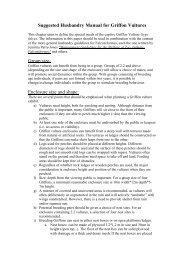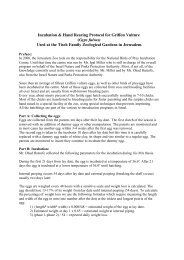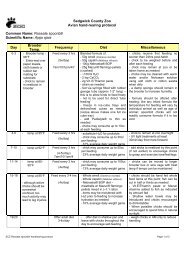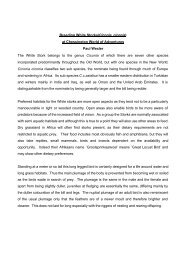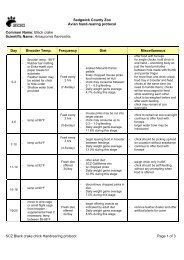White-browed Coucal Hand-rearing - Avian Rearing Resource
White-browed Coucal Hand-rearing - Avian Rearing Resource
White-browed Coucal Hand-rearing - Avian Rearing Resource
You also want an ePaper? Increase the reach of your titles
YUMPU automatically turns print PDFs into web optimized ePapers that Google loves.
<strong>White</strong>-<strong>browed</strong> <strong>Coucal</strong> <strong>Hand</strong>-<strong>Rearing</strong><br />
Louise Peat<br />
Cotswold Wildlife Park<br />
The Cuculiformes is a fascinating order that contains two distinct families;<br />
Musophagidae (turacos) and Cuculidae (cuckoos). The subfamily Centropodinae<br />
contains twenty-eight species of coucals of which the <strong>White</strong>-<strong>browed</strong> <strong>Coucal</strong><br />
Centropus superciliosus is the only representative in captivity in the European region<br />
(ISIS species holdings September 2008).<br />
There are four recognised subspecies of the <strong>White</strong>-<strong>browed</strong> <strong>Coucal</strong> Centropus<br />
superciliosus which are distributed from Arabia, Ethiopia, through to Kenya, Uganda,<br />
Tanzania, Zimbabwe and South Africa.<br />
They inhabit dense bush and moist vegetation where<br />
they feed on a diet of mostly insects; grasshoppers,<br />
crickets, locusts & beetles, also lizards, frogs, mice<br />
and small birds.<br />
Pairs are monogamous and nest in large untidy dome<br />
structure with a side entrance, built from grass and<br />
twigs, lined with leaves, usually in reeds or bush.<br />
They lay three to five white eggs, which are incubated<br />
mainly by the male for a period of 14-15 days. The<br />
young are fed by both sexes. Chicks emit a foul<br />
smelling black cloacae liquid when disturbed. The<br />
chicks fledge at 18-20days, at this point they are<br />
barely able to fly and mostly creep about waiting for<br />
adults to feed them.<br />
Cotswold Wildlife Park first started working with <strong>White</strong>-<strong>browed</strong> <strong>Coucal</strong> in 2004<br />
when we received six birds from Parc Paradisio, Belgium. Three birds went to<br />
Exmoor Zoo to set up a second breeding pair, and we retained an unrelated pair and a<br />
female offspring.<br />
The birds are kept in an aviary with two further representatives on the Cuculiforme<br />
order, Guira Cuckoo Guira guira and Roadrunner Geococcyx californianus. The<br />
three species cohabit peaceable together and rarely interact.<br />
In 2005 we successfully hand reared one coucal and then went on to parent rear three<br />
birds. Since then a further nine birds have been successfully parent reared.
Early on in 2008 the adult pair hatched several clutches, but only one chick survived.<br />
Due to the long list of collections expressing interest in this species and the age of our<br />
adult pair we decided to intervene and maximise on this years breeding. Three<br />
clutches (a total of sixteen eggs) were taken for artificial incubation. Fourteen of the<br />
eggs hatched.<br />
Using information based on the 2005 hand reared bird, an old e-mail communication<br />
from Walsrode based on coua <strong>rearing</strong> and an article written by Exmoor Zoo I put<br />
together a <strong>rearing</strong> protocol, which has been tweaked through the <strong>rearing</strong> process<br />
resulting in a comprehensive and easy to use protocol.
<strong>White</strong>-<strong>browed</strong> <strong>Coucal</strong> hand raising protocol.<br />
Age Diet Comments Growth Stage<br />
0<br />
1<br />
Kept hydrated with distilled water carefully dribbled onto beak with<br />
syringe - generally lapped up by bird. Offer every few hours for 1st 24<br />
hours<br />
Chick placed in small basket<br />
with tissue substrate.<br />
Chick’s blind- covered in<br />
white hairs - generally alert &<br />
responsive to both noise<br />
Hatch weight 6.7 - 7.9g<br />
stimulation and touch (jerky<br />
Do not tend to defecate during movements when touched,<br />
Brooder temp 35 degrees<br />
first 24 hours<br />
Bird monitored closely for<br />
gaping & alert to noise).<br />
Mouse pinkies (milk sac removed and during early days all sharp bones hydration level - faeces is a<br />
removed) - waxworms (head removed) Each diet item is placed in luke good indication. Normal<br />
warm distilled water for a few seconds directly before dropping item into faeces should be enclosed in<br />
mouth. One feed per day has Nutrobal dusted over it. Chick is only fed a faecal sac - any changes to<br />
when gaping - and is never fed more than 10% of AM bodyweight per this could indicate problems.<br />
feed (generally much less). Decrease/increase amount fed by monitoring Raised humidity levels in<br />
daily weight gain. 6-7 feeds between 7am - 10pm - adjust to intake of brooder will encourage<br />
individual - initially fed every 2 to 2.5 hours<br />
defecation. 0.5g<br />
Average<br />
intake per<br />
feed.<br />
Average<br />
growth<br />
rate %<br />
2<br />
Defecation should take place<br />
every other feed - If this is not<br />
occurring, handling the chick<br />
can induce defecation -<br />
stimulation of the cloaca with<br />
a warm damp cloth can also<br />
22.9<br />
be affective. 0.8g<br />
3 1g 24.32<br />
4<br />
Feed every 3 hours<br />
5 Brooder temp 34 degrees<br />
6<br />
7<br />
8<br />
Tend to defecate after every<br />
feed, from this point<br />
Slits in eyes should now be<br />
apparent 1.5g<br />
Pin feathers start to protrude<br />
on edges of wings & tail 1.8g<br />
Pin feathers start to protrude<br />
along spine and underside of<br />
neck 2g<br />
Pin feathers along sides of<br />
torso 2-2.5g<br />
9 3g<br />
2.5 - 3g<br />
Start to introduce crickets - legs, wings & heads removed.<br />
Day 10 to 12 reduce to 5 feeds<br />
10 Brooder temp 32 degrees up to 3.5g<br />
11<br />
12<br />
13 Brooder temp 30 degrees<br />
14<br />
Body should now be covered<br />
in pin feathers 4g<br />
Feathers should be emerging<br />
from pins - start to explore<br />
surroundings<br />
15<br />
Change in vocals - adult<br />
sounding 5g<br />
Access to dish of food. 4 feeds daily<br />
16 Brooder temp 26 degrees Fully feathered<br />
17<br />
18<br />
Intake<br />
amount<br />
drops off<br />
ready for<br />
Toe grip getting stronger - flight<br />
should be attempting to perchweight.<br />
Generally able to perch from<br />
this point<br />
19 Attempts to fly<br />
20<br />
Keep keen to encourage self-feeding - start to wean onto adult diet.. .<br />
2-3 feeds daily with all day access to adult diet<br />
Room temp 20 degrees<br />
6.49<br />
29.87<br />
27.79<br />
27.39<br />
20.54<br />
20.5<br />
17.31<br />
13.85<br />
11.02<br />
12.25<br />
10.42<br />
8.27<br />
8.73<br />
8.05<br />
4.92<br />
3.33<br />
3.33<br />
0.84
120<br />
100<br />
80<br />
60<br />
40<br />
20<br />
0<br />
Growth Rate<br />
1 2 3 4 5 6 7 8 9 10 11 12 13 14 15 16 17 18 19 2 21<br />
Age<br />
General <strong>Rearing</strong> Notes<br />
All the chicks were kept in separate baskets to enable better individual monitoring, as<br />
they grew, if too close to each other aggressive mouthing would occur during feeding<br />
times. From day 15 chicks were placed together in a hospital cage. At this stage<br />
minimal aggression was observed (generally pre-feeding excitement only), the chicks<br />
generally spend time in close proximity to each other. Always take care to place birds<br />
together of similar ages as younger birds tend to get trampled on.<br />
Weighing the chicks was initially done several times a day but each time the chick is<br />
handled it becomes stressed and stops feeding, therefore weighing was performed<br />
once a day only in the morning ten minutes before the first feed.<br />
As the chicks grow a second afternoon handling for a general physical check is also<br />
advisable. The birds develop rapidly and differences can be seen from feed to feed,<br />
with pinfeathers growing rapidly through the day. Always check leg development and<br />
toes, from day three they should be pushing up on their legs to get to food, if they are<br />
not doing this it could indicate a problem.<br />
Whenever stressed chicks have a delightful olfactory defence mechanism, they<br />
produce smelly runny brown liquid faeces; on producing this chicks are very subdued<br />
for a few minutes. The first time you experience this it can be quite concerning, I was<br />
certainly fooled into thinking I had a very ill bird on my hands. One particular<br />
nervous chick was a habitual offender, the slightest change to routine would upset<br />
him, and even hearing a different voice in the room whilst being fed would result in<br />
an odorous event!<br />
If the chick is sluggish and unresponsive check for bloating, this occurred quite early<br />
on with one chick which had the lowest hatch weight, this specimen was very<br />
Boris<br />
Eric<br />
Kurt<br />
Billy<br />
Burt<br />
Benny<br />
Belle<br />
Jules<br />
Dirk<br />
Wayne<br />
Duke
uncomfortable, extremely bloated and quickly became unresponsive. Worried about a<br />
potential infection the bird was placed on a four day course of 2.5% oral Baytril (one<br />
small drop on the food) this was followed by a 5 day course of pro-biotic. The chick<br />
responded to treatment slowly and eventually began feeding without assistance.<br />
Strangely this specimen lacked the black markings on the tongue and in hindsight I<br />
wonder if this individual would have survived if parent reared. The bird is now a<br />
healthy looking character and thriving alongside his siblings.<br />
Baby Belle – no black makings on tongue: Sibling Benny - normal tongue markings.<br />
Always aim to keep the chicks keen and eager to feed, appetite varies through the<br />
various developmental stages, with appetite at its strongest when feathers begin to<br />
emerge from the pinfeathers. As a general rule once the birds get to between 90 and<br />
100 grams in weight appetite takes a dive (18-20 days of age), chicks become much<br />
more interested in surroundings and are ready to fledge.<br />
In total three clutches of eggs were taken, the first consisted of six chicks, two of<br />
which were not producing normal faecal sacs. They died in quick succession and<br />
without warning; one had produced a large quantity of faeces overnight. Both had<br />
been active and alert up until the point of death.<br />
A third chick from the first clutch was euthanased, it hatched with an overshot lower<br />
mandible, as it grew the left side of the body did not develop at the same rate as the<br />
right. The left leg bone between the foot and ankle had not grown at all since hatch,<br />
and the left eye began to bulge in the eye socket. I have never come across this before<br />
and would be interested to hear from anyone who may have an explanation for this<br />
condition. At this point I can only theorise that this individual had some kind of<br />
mechanical defect.<br />
Over the course of the year a total of 11 chicks were successfully reared, each one<br />
being a different character with varied needs. From mid July to the end of October<br />
my life has revolved around these needy characters and now that the breeding season<br />
has finished I find myself feeling a little lost!
References<br />
Avicultural Magazine, Vol 113, No.4 2007, <strong>Hand</strong>-<strong>rearing</strong> a <strong>White</strong>-<strong>browed</strong> <strong>Coucal</strong> at<br />
Exmoor Zoo, Derek Gibson.<br />
Del Hoya, J., Elliott, A. & Sargatal, J. eds. (1997). <strong>Hand</strong>book of the Birds of the<br />
World. Vol4. Sandgrouse to Cukoos. Lynx Edicions, Barcelona.



